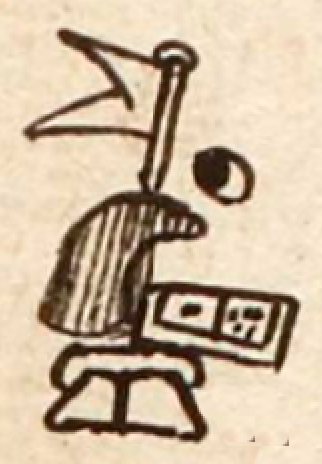Tlalticpaque (Verg12v)
This black-line drawing of the compound glyph for the personal name Tlalticpaque (“He Has Land Up Above," attested here as a man’s name) shows a bird's eye view of a rectangular parcel of land that is segmented into two portions and has a border along the bottom and the two sides. One has one large black dot in the middle; the other side has many small dots (perhaps suggesting cultivation). Below the land are a set of two front teeth (tlantli), providing some phonetic support for the "Tlal-" start to the name. To the left of the land element is a man's hairdo (which might be tzontli). Perhaps this is a semantic indicator pointing to what is on top (but referring to land in this case). Above the hair is a vertical pole with a banner blowing to the left. The banner has a triangular cut out, resulting in the style of a European flag of two points. The flag pole also has a cap on the top. One more item, suspended in the air to the right of the banner, is a small, circular black and white object. This may be a bean [etl, providing the phonetic dimension for the -e at the end of the name.
Stephanie Wood
Tlalticpac refers to being on the land or on the Earth. The -que ending could be incorporating an -e suffix of possession, which would change the meaning to someone who had land up above or up high. While the -que plural suffix refers to people in the plural, it only attaches to nouns ending in -e or -hua (with exceptions being ilamatque and huehuetque).
Stephanie Wood
luis.tlalticpaque
1539
Jeff Haskett-Wood
dientes, tierras, parcelas, banderas, pelo, cabello, nombres de hombres

tlal(li), land, https://nahuatl.wired-humanities.org/content/tlalli
ticpac, up above, on top, https://nahuatl.wired-humanities.org/content/ticpac
pa(mitl), flag, https://nahuatl.wired-humanities.org/content/pamitl
tlan(tli), teeth, https://nahuatl.wired-humanities.org/content/tlantli
tlalticpac, on earth, earthly, https://nahuatl.wired-humanities.org/content/tlalticpac
-e (possessive suffix), https://nahuatl.wired-humanities.org/content/e-0
-que (plural suffix), https://nahuatl.wired-humanities.org/content/que
e(tl), bean, https://nahuatl.wired-humanities.org/content/etl
Él Con Tierras Arriba (?)
Stephanie Wood
Codex Vergara, folio 12v, https://gallica.bnf.fr/ark:/12148/btv1b84528032/f32.item.zoom
The non-commercial reuse of images from the Bibliothèque nationale de France is free as long as the user is in compliance with the legislation in force and provides the citation: “Source gallica.bnf.fr / Bibliothèque nationale de France” or “Source gallica.bnf.fr / BnF.” We would also appreciate a citation to the Visual Lexicon of Aztec Hieroglyphs, https://aztecglyphs.wired-humanities.org/.



